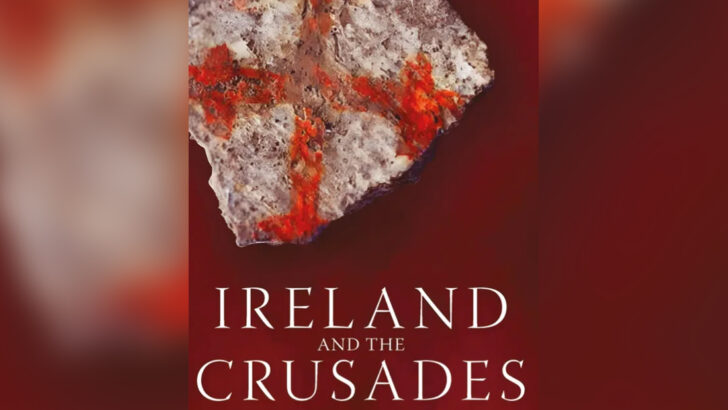Ireland and the Crusades,
edited by Edward Coleman, Paul Duffy & Tadgh O’Keefe
(Four Courts Press, €49.50 / £41.50)
I cannot be the only one who has wondered over the years about medieval Crusaders from Ireland. Across Western Europe, from Scotland to Sicily, the adventures and misadventures of these knights of the Red Cross are celebrated.
Yet in Ireland historians left us in the dark. Hence the great interest of this book. While not a definitive history, this series of essays by several hands casts a flood of light which, for me at least, has long been a dark corner of our national story.
These days crusaders have a bad name. Popularly they are thought of as brutal invaders of “Arab lands” that deserve reprobation.
Yet this is surely a mistaken perspective. The countries they wished to liberate from the Muslim rule, had been non-Arab and non-Muslim until the Arabs horde burst out of the deserts of Arabia in 622AD to slew out over Syria, Egypt, North Africa, Asia Minor, and parts of Asia proper.
Nations
Most of these regions were all originally Christian nations. It was the Arabs who were the brutal interlopers. This is often overlooked. The crusades were mounted to throw back the invaders and their new and alien culture, and to restore Christianity to Palestine.
The battle of Toulouse in 721 saw at last the turn of that tide when the Muslim invasion of France was thrown back; though it was not until 1492, the year of Columbus, that the Moors were finally expelled from Spain.
But by this time the Arab expansion was not only failing, Arab society had failed to develop its scientific knowledge. Indeed North Africa which had been the “breadbasket of Rome” declined into sterility and desert under Arab and Ottoman rule, as did Mesopotamia. They made strides in chemistry and the use of gunpowder, but the achievements of the Greeks, which they preserved, but which in their hands did lead to industrialisation.
For a larger view of the subject readers will still benefit from Sir Stephen Runciman’s three volume classic A History of the Crusades. For other tastes there is that classic novel, Knight with Armour by Alfred Duggan, much admired by Evelyn Waugh, which still retains its lean and effective power. For younger readers there is Ronald’s Welsh’s most evocative Knight Crusader, which set off my own interest in this era as a schoolboy; it is still available from Slightly Foxed Editions.
The crusade zeal was a matter for the Anglo-Norman community. The chieftains of Gaelic Ireland had little interest in freeing Jerusalem from aliens, when they desired to free Ireland from its own invasive aliens”
The main focus of Ireland and the Crusades is not surprisingly on actual crusades, but on the activities of the Military Orders that spring from them, the Templars, and the Knights Hospitallers, and their role in local history in Ireland. These essays break new ground and will be read with interest in many districts of Leinster and Munster.
The crusade zeal was a matter for the Anglo-Norman community. The chieftains of Gaelic Ireland had little interest in freeing Jerusalem from aliens, when they desired to free Ireland from its own invasive aliens. The earlier warfare with the Vikings was recast around the battle of Clontarf as a crusade against dangerous pagans.
But then in turn the Normans claimed that by invading Ireland they were purifying the deviant Christianity of the Irish (as described so dubiously by Gerald de Barri). Centuries later the Irish chieftains, at the time of the Flight of the Earls, around 1607, failed to arouse Papal interest in a crusade in Ireland against the now Protestant English in Ireland, as Kathryn Hurlock explores in her contribution.
Crusaders
Not that there were a few real crusaders. The essay by Ciaran McDonnell on Geoffrey de Geneville and his brother Jean de Joinville , “from the Boyne Valley to the Holy Land”, does deal with actual crusading, though some of it was against the Cathars in the Occitane in the 12th century, which was at heart more an effort to extend the domains of the King of France that to deal with heretics. It did not involve Muslims at all.
Tadhg O’Keefe provides a final summary of the state of the matter. Over the last few years interest has strongly revived among historians about crusader matters in Ireland. New research has expanded on the limited explorations of Litton Falkiner in the 19th century, revealing neglected aspects of Irish history that deserve further exploration.
For folklore enthusiasts of Dublin Emer Purcell provides an account of the supposed “Crusader mummy” of St Michan’s Church, which along with a supposed “nun”, was for long a sight of Dublin.
However, earlier this year the vault in Church Street was broken into and the coffins vandalised and mummies burned. The vault is now closed, the future of the exhibition uncertain.
An expert from the National Museum, so I have just been informed, is due this week or next to inspect the damage, and perhaps take samples to assess the age of the remains.
It is doubtful that they will ever again be on show. In future rather than Crusader of old visitors will have to make do with the coffins of the patriotic brothers Sheares from 1798


 Peter Costello
Peter Costello
